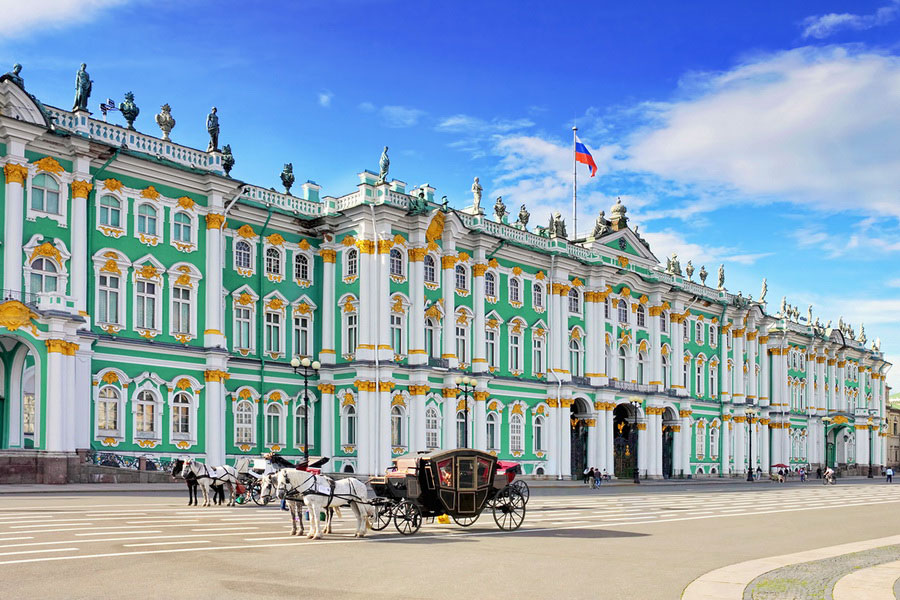
Museums in St. Petersburg, Russia have long been central to a city regarded as the pearl of Russian cultural life. From fledgling galleries to internationally acclaimed establishments, each museum serves as a purveyor of the city’s eventful past and a reminder of its inhabitants’ love for that which is innovative and extravagant.
To truly appreciate this iconic city, there is no better place to start your exploration than with the top 10 Museums in St. Petersburg. Be it precious jewels, artistic masterpieces, imperial possessions, exotic paraphernalia or eclectic creations, the exhibits you will discover within the walls of each museum bear the imprint of gifted artists, architects and revolutionary thinkers who have come and gone over the centuries.
From beloved mainstays to the downright quirky, below we introduce you to the Top 10 Museums in St. Petersburg.
State Hermitage Museum
Founded in 1764, State Hermitage Museum has been a highlight of St. Petersburg for generations. This iconic museum contains the largest collection of cultural-historic items in all of Russia and is so expansive that it would take days or even months to tour all of its treasures!
The museum’s name is derived from French and denotes a “secluded corner". It was founded under Catherine the Great, who had an additional wing added to her home to accommodate the many prized paintings which she had amassed from Europe. The royal collection continued to expand through the years, although it was not made available for public viewing until the mid-19th century.
Today the museum, located in the heart of St. Petersburg on Palace Square, includes more than 350 halls dispersed among several buildings. The most famous of these is Winter Palace, which was once a residence of Russian emperors.
The Hermitage is filled with brilliant creations from around the world , including large collections of sculptures, ceramics, precious metals and historic artifacts. Yet it is the art gallery at State Hermitage Museum which deserves special recognition. Originals by Leonardo da Vinci, Raphael, Rubens, Velazquez, Titian, El Greco, Caravaggio, Van Gogh and Kandinsky are all on display, as well as the largest collection of Rembrandt paintings outside the Netherlands.
Generations of students from St. Petersburg Academy of Arts have pursued their studies in the halls of The Hermitage, gaining invaluable experience as they delve into the secrets of each masterpiece. Museum staff likewise do an excellent job of helping patrons grasp the significance of each exhibit through organized tours, special lectures, guidebooks and photo albums.
When in St. Petersburg, a visit to State Hermitage Museum is a must, for it is sure to heighten your appreciation for the talent of some of the world’s most gifted artists.
Kunstkamera (Peter the Great Museum of Anthropology and Ethnography)
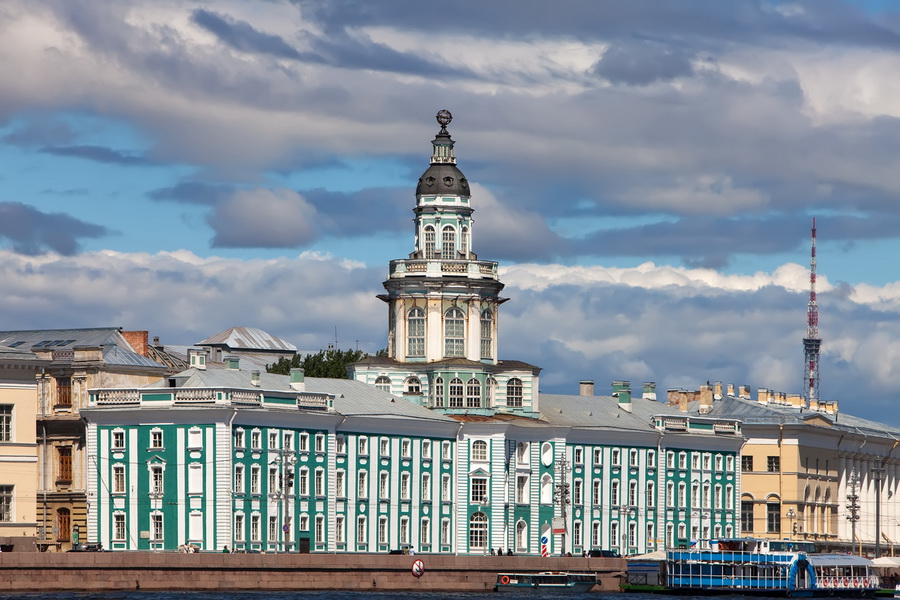
Kunstkamera is one of the oldest museums in Russia, having been founded by Peter the Great in the early 1700s in order to showcase the large assortment of human oddities and anatomical curiosities which he had amassed. The tsar’s collection was deemed to be of scientific interest and was particularly useful for disproving superstitions which ran rampant in Russia at that time.
Exhibits continued to increase over the next two centuries as Russian travelers, navigators and scientists donated their ethnographic findings to Kunstkamera. Even the acclaimed scientist Mikhail Lomonosov contributed valuable descriptions for many of the minerals stored in the museum. Kunstkamera was transferred to the Academy of Sciences in the early 18th century and soon became one of the leading educational institutions in St. Petersburg. As strange and unusual items from around the globe were gathered over the years, the original display of oddities grew into numerous exhibits which are now divided by country and geographic region.
Today, Kunstkamera – now officially called Peter the Great Museum of Anthropology and Ethnography - contains more than a million exhibits. It is often referred to as the “Museum of Horror” thanks to its famous anatomical exhibition hall, which three centuries after its opening continues to hold a bizarre fascination for many. Although most of the original eccentricities remain, Kunstkamera is now largely a historical reflection of the everyday life of peoples from around the world. Visitors will discover entire rooms dedicated to Japan, Australia, Indonesia, India, Mongolia, Africa and the Americas, in addition to exhibits on astronomy and the life of Lomonosov.
Russian Lefty Microminiature Museum
Among the more unusual of our Top 10 Museums in St. Petersburg is Russian Lefty Microminiature Museum. The gallery opened in 2006 in a historic 1777 mansion and features 75 microscopic carvings which are less than a millimeter in size, plus dozens of additional unique pieces of local art.
The museum’s name was inspired by a famous fairy tale by Nikolai Leskov, "The Tale of the Cross-Eyed Lefty from Tula and the Steel Flea" which tells the story of a skilled left-handed artisan. The gallery’s main exhibits showcase 75 unique creations of Vladimir Aniskin, a Siberian physicist and an extraordinarily gifted, self-taught craftsman. The production of each miniature takes Aniskin anywhere from 3 weeks to 7 months and requires many skills, including jewelry making, blacksmithing and artistic glass casting.
So miniscule are Aniskin’s creations that they are almost invisible to the naked eye and must be viewed through the special optical equipment installed on the exhibition tables in the museum’s two halls. Each work displays Aniskin’s keen eye for beauty and his unmatched patience, qualities necessary for creating such miniature perfections as a caravan of platinum camels, a rosebud hidden in a horsehair, a watercolor drawing on a sliver of apple bone and the famous flea with silver horseshoes inspired by Leskov’s tale. Microscopic carvings chiseled into dustings of precious metals, poppy seeds, rice, birch bark and glass never cease to amaze and increase appreciation for the (very) little things in life.
The ever-expanding collection at Russian Lefty Microminiature Museum also includes sculptures, paintings and miniatures created by other Russian and foreign artists.
Peter and Paul Fortress
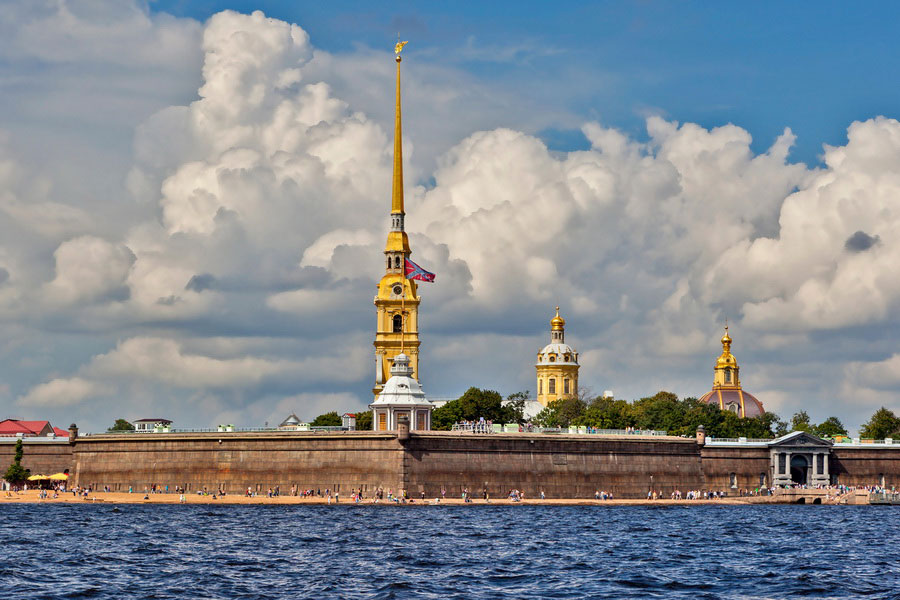
Peter and Paul Fortress, the very first building of St. Petersburg, was founded by Peter the Great in the autumn of 1703 in preparation for a potential attack from Sweden. Over the centuries it has served not only as a defensive structure but also as a political prison and a tomb for Russian emperors.
The fortress began as an earthen outpost which was erected on the Neva River and armed with cannons. In its center was a small, traditional wooden church crowned with three spires which was named in honor of the Apostles Peter and Paul. Not long after construction, the original wooden church was replaced with the famous Peter and Paul Cathedral which greets visitors today. The first stone chapel in Russia, it remains one of St. Petersburg’s most iconic sites. The original wooden spires were replaced with metal ones, the tallest of which spirals upward from the bell tower at a collective height of 122.5 meters, making the cathedral one of the tallest buildings in the city.
Inside, the cathedral walls are adorned with eighteen frescoes depicting Biblical scenes which were painted by prominent artists in the latter half of the 18th century. Yet the main attraction is a majestic arch-shaped iconostasis which is considered one of the finest examples of Russian woodwork. To the right of the southern choir loft entrance is the tombstone of Peter I, the first of many members of the royal Romanov family to be buried in the cathedral.
Peter and Paul Fortress doubled as a political prison almost since its founding, yet the infamous Trubetskoy Bastion Prison was not built until 1862. Notorious for its isolation cells and torture chambers created specifically for political dissidents, the prison remained active until the early 20th century. Famous prisoners incarcerated in the fortress included authors Fyodor Dostoevsky and Maxim Gorky and a brother of Vladimir Lenin.
In front of Peter and Paul Fortress is one of Russia’s most unusual monuments to Peter I. Created by sculptor Mikhail Shemyakin in 1991, its rather unflattering proportions continue to spark debate.
Considering its role in the early formation of St. Petersburg, its architectural beauty and the intriguing secrets which it holds, Peter and Paul Fortress is not to be missed during your city tour.
State Russian Museum
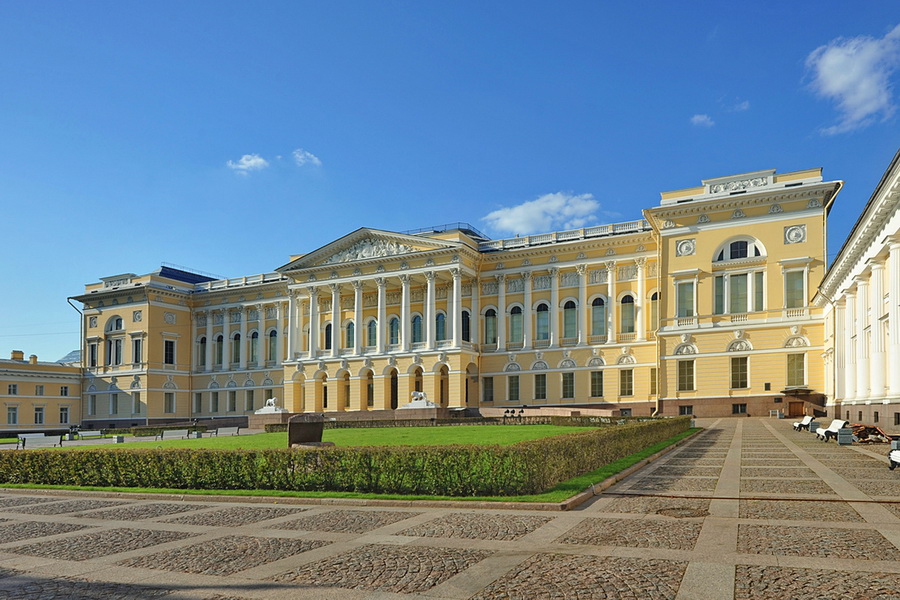
State Russian Museum of St. Petersburg holds the largest collection of Russian art in the world. Inspiration for the gallery came from Alexander III in the mid-19th century, yet the tzar himself was unable to bring his plans to fruition. The museum’s establishment was deferred until 1895, when it opened under Nicholas II, the last emperor of the Russian Empire.
The current collection at State Russian Museum consists of over 400 thousand paintings, coins, sculptures, rare photographs and exhibits of folk and applied art dating from the 14th century to the present day. The items have been amassed from prominent museums and palaces across Russia as well as from private collections. The extensive complex includes 3 palaces, a castle, several pavilions and gardens, all of which are in themselves a sight to behold.
Peterhof State Museum-Reserve (Peterhof Palace)
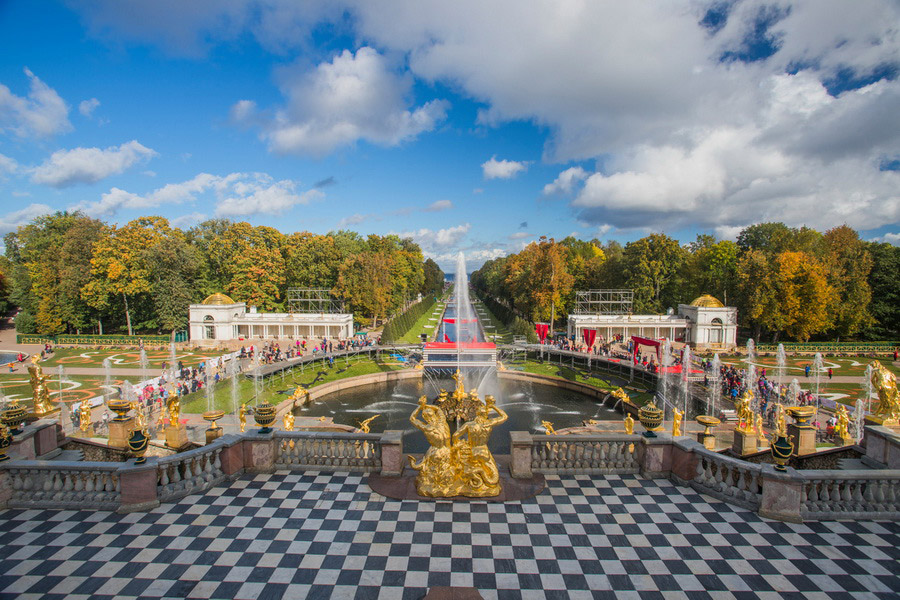
The extensive grounds of Peterhof Palace were laid in the early 1800s as a symbol of the triumphs which the burgeoning Russia was experiencing both on the battlefield and at home. Today Peterhof State Museum-Reserve is one of the most popular museums in St. Petersburg region, a UNESCO site which is adored for its stunning 18th-19th century architecture and immaculate gardens that showcase the talent of its designers and the city’s rich heritage.
Peter I himself was the mastermind behind the complex which still bears his name. The first building to be erected was Monplaisir Palace which, as noted in a campaign log kept by the emperor himself, was completed in 1714. His active participation in the design of Peterhof is confirmed by the tsar’s personal notes, drawings and decrees in regard to the complex which have been preserved to our day. By the time of the emperor’s death, a significant number of palaces and fountains had already been added to Peterhof, which continued to be expanded over the next 150 years.
Peterhof Palace was the site of a vicious battle between the Russians and Germans during World War II which destroyed much of the complex. Ongoing restoration work continues, but thanks to the skill of countless sculptors and architects over the years, the ensemble has been masterfully restored to its historical look.
The grandiose grounds of Peterhof State Museum-Reserve include eleven parks, nearly thirty palace buildings, many pavilions and hundreds of marble statues and busts. So elaborate is the complex that it has been nicknamed the Russian Versailles and requires a full day to explore at length. Peterhof is a one-hour drive from St. Petersburg and is also accessible by boat from State Hermitage Museum.
Shadow Museum
Shadow Museum, a recent addition to the St. Petersburg museum scene, is not a set of static objects but a fluid space for innovative creativity.
Every exhibit in this unique art space is a shadow created by the use of lighting and brilliantly placed objects. Although the subject matters may at first appear haphazard, they are all united by the common theme of St. Petersburg. Each structure is equipped with lighting devices located at a specific angle so that the play of light creates a shadow visualization of famous St. Petersburg sights, historical figures and non-standard views of the city inspired by the museum founder’s personal perceptions.
A trip to Shadow Museum allows you to awaken your imagination and stretch your abilities as you observe ordinary household items from a whole new angle. Far from your typical gallery, the interactive museum can only be experienced on one of the tours which are offered at regular intervals throughout the day in both Russian and English. You will even have the opportunity to play around with the concept of shadow art by creating your own original shadow designs!
Faberge Museum
Faberge Museum is filled with some of the finest luxuries of Faberge, Russia’s internationally acclaimed jewelry company which has been designing unique and valuable pieces ever since its founding in St. Petersburg in 1842. The museum opened in 2013 in a gorgeous palace which was built at the turn of the 19th century and is as ornate as the dazzling objects which it hosts.
With thousands of exhibits and over 1000 exclusive jewelry items crafted from precious metals and stones, Faberge Museum is sure to delight the eye. Its collections include ceremonial silver, jewelry, valuable household goods and other personal items which belonged to the imperial Romanov family, as well as icons, clocks and other lavish handcrafted items dated to the 18th-20th centuries. Yet the museum highlight are the bejeweled Imperial Easter Eggs which were created by Karl Faberge for Alexander III and Nicholas II, the last two emperors of Russia. The rich collection of 9 unduplicated eggs is the largest of its kind in the world and even includes miniature surprises discovered inside some of the eggs.
Faberge Museum combines elegance, originality and St. Petersburg history in a delightful experience which will not be soon forgotten.
Russian Railway Museum
In 1896, the Lumiere brothers invited the public to watch a premiere of a short documentary called "The Arrival of the Train at La Ciotat Station". Well over a century has passed since the groundbreaking film was first viewed in France, and although both cinema and rail travel have since become a part of everyday life, they are still capable of awakening our imagination and transferring us to a simpler era.
At Russian Railway Museum in St. Petersburg, multimedia presentations combine with interactive exhibits to create a fun and informative time for visitors young and old. The museum first opened in the 1970s but was expanded and relocated to an old train station in 2017.
Russian Railway Museum now holds one of the largest collections of railway transport in the world, including over 1000 items connected with rail travel and more than 100 rare exhibits of train cars, historical engines and other large pieces of railway equipment. As you walk between the massive trains now symbolic of a bygone era, hop onto a handful of rail cars which are open for visitor exploration and experience the museum’s many interactive exhibits, you may just feel like an authentic time traveler. Historical and modern exhibits alike – including old conductors’ uniforms, well-used tracks, a unique missile system, a replica of Russia’s first passenger train and one of world’s fastest diesel trains - help visitors to appreciate the vital role of rail transport past and present. Placards are in Russian and English, and tours in English are also available.
The State Museum of the History of Religion
True to its name, The State Museum of the History of Religion introduces patrons to the history and ancient writings of many world religions, and in the process provides a fuller understanding of those who adhere to each faith. The only museum of its kind in Russia, it boasts of nearly a quarter million items from seemingly every era and corner of the earth.
The St. Petersburg museum officially opened in 1932 under the directive of Vladimir Germanovich Bogoraz, a respected Russian ethnographer and religious historian. Permanent exhibitions cover the founding and development of religions from as early as the 6th millennium BC, including separate halls for Russian Orthodoxy, Catholicism, Protestantism, Islam, Buddhism, Confucianism and Taoism. A special section dedicated to the emergence of monotheism covers both Judaism and Christianity. For each religion, items of interest including scrolls, books, religious paraphernalia and artwork from various centuries have been amassed.
In 2011, The State Museum of the History of Religion opened the permanent exhibition "The Beginning of Beginnings". Designed specifically for children, the display introduces young people to mythology and to beliefs on the origin of the world.

